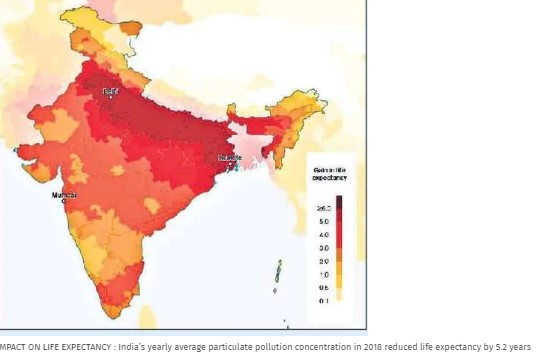Focus: GS-III Environment and Ecology, Prelims
Why in news?
Pollution levels in India reduces 5.2 years from the life expectancy of the average Indian according to an assessment by the Energy Policy Institute at the University of Chicago.
Assessment Highlights
- India is the second most-polluted country globally after Bangladesh, while Nepal, Singapore and Pakistan are the other top countries with dirty air.
- According to the AQLI (Air Quality Life Index) India’s yearly average particulate pollution concentration of 63.2 ug/m3 in 2018 reduced life expectancy of the average Indian by 5.2 years.
- The life expectancy lost in 2016 was 6.1 years when the particulate pollution was at 71ug/m3.
- So, as the particulate pollution which is linked to diseases affecting the lungs and heart reduced from 2016 to 2018, the life expectancy increased improving the situation.
- Pollution most acutely hits people living in the Indo-Gangetic plains.
- Lucknow is the most polluted district in the country followed by 13 other districts, all in Uttar Pradesh.
- The National Capital Territory of Delhi is the 15th most-polluted region in the country.
- China, however, stands out as a success story as per the data. Singapore, China and India were the three most polluted countries in 1998 but by 2018 China improved to being only the seventh most polluted and had improved its life expectancy by 1.3 years. Singapore has also improved.
- A quarter of India’s population is exposed to air pollution concentrations not recorded in any other country, with 248 million people in north India on track to lose more than 8 years of life expectancy if the same pollution levels persist.

Suggestions in the assessment
The AQLI tells citizens and policymakers how particulate pollution is affecting them and their communities and can be used to measure the benefits of policies to reduce pollution.
No shot in the arm will alleviate air pollution and the solution lies in robust public policy.
-Source: Hindustan Times



